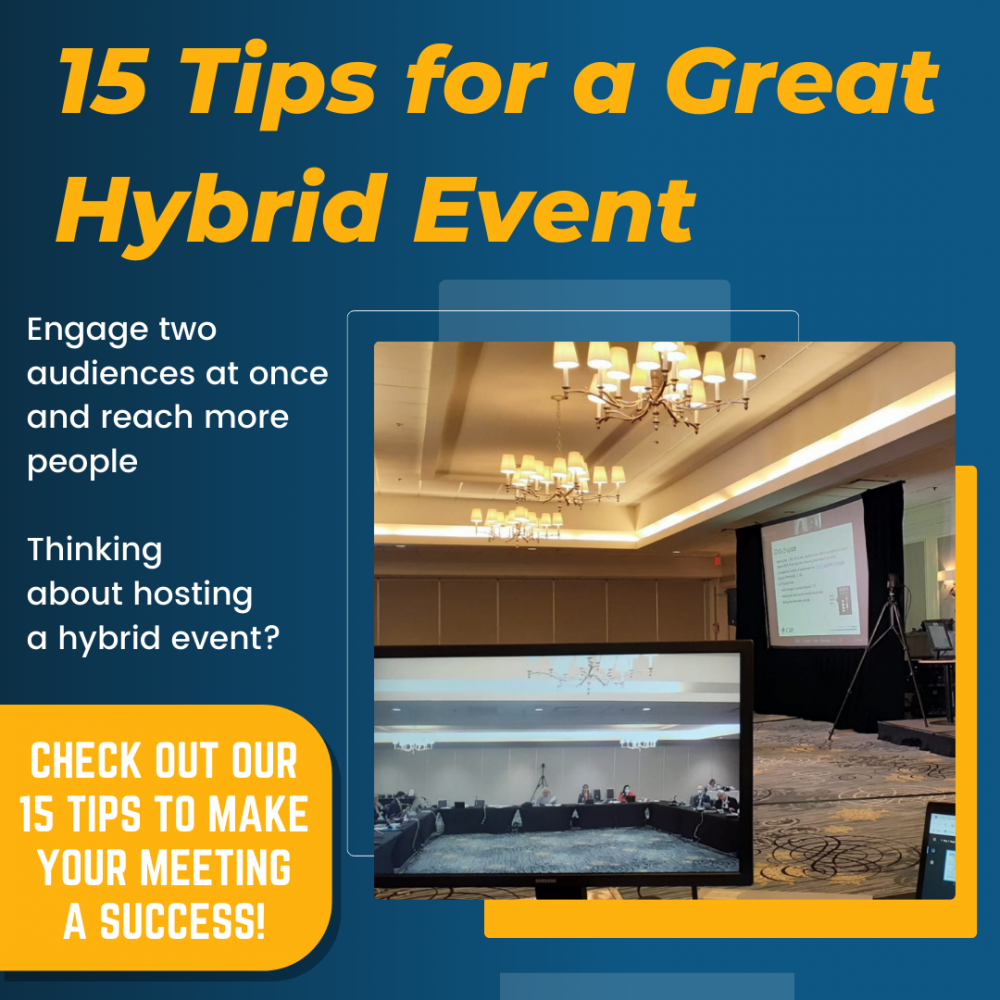15 Tips for a Great Hybrid Meeting

1. Use the right Platform
The platform you choose needs to have adequate features to power hybrid events. Among the most important features are those that enable both virtual and in-person attendees to engage with each other through the same platform via a mobile app for live attendees and a desktop option for those in the remote audience.
It’s also important to choose a hybrid platform that can facilitate interaction between the speakers and the audience as well as provide detailed analytics by tracking such actions as poll responses, time spent at sessions, feedback and more.
2. Venue Support
A venue with the bandwidth, tech support and backup plan that can serve an in-person event may not be extensive enough for a hybrid event. The venue must be able to manage multiple video streams as well as online connections for attendees. It’s essential to make sure the venue has the bandwidth and tech support capabilities required.
3. Testing and Rehearsing
While not always given priority, testing and rehearsing components of the virtual aspects of a hybrid event are just as important as the in-person aspects. All of the tools need to be tested in advance, including features such as Zoom, polling and gamification. So do the light, sound, video and other components.
Make sure the facility has technical back-up in case the power should go down, as that could sabotage the entire event. Have a backup plan in place with both the facility and platform provider.
4. Treat Both Audiences the Same
While establishing a connection between the remote and in-person audience is important for engagement, not everything is going to be relevant for both audiences. It’s important to provide some customized content for each audience, which can be accomplished by using a hybrid platform that can set up separate agendas and communication channels.
5. Promotion
When promoting the event, make it clear that it will be a hybrid event and what the specific offerings will be for each audience. As the full schedule goes online, build viewer interest through regular, timed releases of content building up to the event. Promote the event on social media and encourage social media by hashtags during the event to build networking for all attendees.
6. Having a Virtual Emcee
Keeping the virtual audience engaged ais important. Hire a virtual emcee to serve as a voice for the remote audience to help them feel they are part of the action. The emcee can moderate the chat, monitor for questions and transmit them to the speakers all with the purpose of engaging those who are not in the room.
7. Planning Team
A hybrid event is vastly different from an in-person event and is subject to problems for planners who are inexperienced with the format. Team members will need training, either from courses or from a professional event agency. Similarly, the A/V or production team needs to be well-versed in video streaming and running hybrid events. It’s important to get your first hybrid event right to retain return clients and build your reputation.
8. Training your Speaker
Speakers who are accustomed primarily to live events may need special training to engage a virtual audience as well. Even speakers with experience in virtual events may also find it hard to engage both audiences. Speakers will want to find ways to engage both audiences at the same time, which may require specific training.
9. Time Zones
For large events with multiple sessions and viewers from disparate time zones, consider pre-recording some of the sessions and bringing both the live and remote audiences together during a keynote address or general session. For repeat sessions, consider playing the pre-recorded session at designated times for different time zones. Ask the presenters to go live at the end of the recorded sessions for Q&A. Global events may require regional hubs to compensate for the time differences.
10. Agenda
The attention span of a virtual audience watching from home iwill usually be less than those who are attending the event in person. Days packed with lengthy sessions are difficult and tiring, especially viewed in front of a screen. An event spread over a few days with shorter session hours is preferable. Both audiences will appreciate getting breaks and having time to network both virtually and in person.
11. Content
Heavy content and long presentations that might be tolerated by a live audience are more difficult for a remote audience to sit through. It’s even more important to keep the content engaging, entertaining and to the point in a hybrid setting. Keep content short and focused, and consider using visuals to please both audiences.
While sessions that run over the designated time period may not be a big problem during in-person events, this creates confusion for online audiences. A remote attendee who plans to join a session at a specific time may find the session is starting later because the previous session ran late. Speakers should be encouraged to keep from running overtime.
12. Sponsorship Opportunities
Virtual events during the pandemic have drawn large audiences, sometimes higher than the live events they replaced. If you feel your hybrid event can draw a large remote audience, there may be potential for lucrative sponsorship. Take advantage of this by offering banner ads, acknowledgments, short sponsor videos, sponsor-hosted sessions, an event website sponsor page and lead generation options.
13. Post-Event Followup
Make recorded content available on-demand after the event. Recorded content produced during the event is not only useful for attendees who want to hear it again, it can be used to promote future events, build membership and create an online community. Also, take opportunities to promote future events to the online attendees, encouraging them to attend in-person in the future. Post-event marketing can include sharing poll information, posting event highlights on social media and other strategies to keep the interest going.
14. Registration
Lately with constantly changing travel restrictions and other regulations, it’s hard for attendees to know if they will be able to attend an in-person event or not. Try to make it easy for attendees to switch from in-person to virtual or vice-versa. Similarly, the event’s agenda should be flexible, allowing attendees to choose which tracks to participate in. This is especially important for virtual attendees who may not want to sit through the entire event.
15. Networking for Virtual Attendees
While networking among in-person attendees usually takes care of itself, the virtual audience may need help. Provide virtual chat rooms and breakout sessions where remote attendees can get to know each other and interact. Other methods can include providing hosts and moderators who assist with interactions, introducing social media channels dedicated to the event, live polling and exchanging virtual business cards.
It's also important to encourage the live and virtual audiences to connect with each other. Provide the in-person attendees with access to the same platform and tools the virtual audience is using, this will give them access to the chat rooms and other virtual networking channels.


